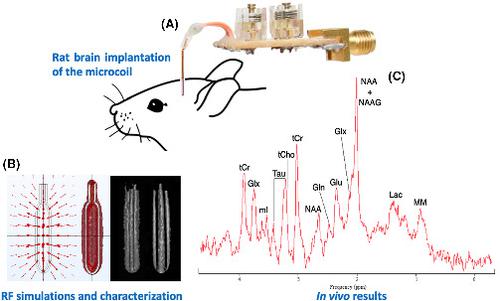当前位置:
X-MOL 学术
›
NMR Biomed.
›
论文详情
Our official English website, www.x-mol.net, welcomes your
feedback! (Note: you will need to create a separate account there.)
Proton MRS on sub-microliter volume in rat brain using implantable NMR microcoils
NMR in Biomedicine ( IF 2.7 ) Pub Date : 2021-06-30 , DOI: 10.1002/nbm.4578 Justine Deborne 1 , Noël Pinaud 1 , Yannick Crémillieux 1
NMR in Biomedicine ( IF 2.7 ) Pub Date : 2021-06-30 , DOI: 10.1002/nbm.4578 Justine Deborne 1 , Noël Pinaud 1 , Yannick Crémillieux 1
Affiliation

|
The use of miniaturized NMR receiver coils is an effective approach for improving detection sensitivity in studies using MRS and MRI. By optimizing the filling factor (the fraction of the coil occupied by the sample), and by increasing the RF magnetic field produced per unit current, the sensitivity gain offered by NMR microcoils is particularly interesting when small volumes or regions of interest are investigated. For in vivo studies, millimetric or sub-millimetric microcoils can be deployed in tissues to access regions of interest located at a certain depth. In this study, the implementation and application of a tissue-implantable NMR microcoil with a detection volume of 850 nL is described. The RF magnetic field generated by the microcoil was evaluated using a finite element method simulation and experimentally determined by high spatial resolution MRI acquisitions. The performance of the microcoil in terms of spectral resolution and limit of detection was measured at 7 T in vitro and in vivo in rodent brains. These performances were compared with those of a conventional external detection coil. Proton MR spectra were acquired in the cortex of rat brain. The concentrations of main metabolites were quantified and compared with reference values from the literature. In vitro and in vivo results obtained with the implantable microcoil showed a gain in sensitivity greater than 50 compared with detection using an external coil. In vivo proton spectra of diagnostic value were obtained from brain regions of a few hundred nanoliters. The similarities between spectra obtained with the implanted microcoil and those obtained with the external NMR coil highlight the minimally invasive nature of the coil implantation procedure. These implantable microcoils represent new tools for probing tissue metabolism in very small healthy or diseased regions using MRS.
中文翻译:

使用植入式 NMR 微线圈对大鼠大脑中亚微升体积的质子 MRS
在使用 MRS 和 MRI 的研究中,使用小型化 NMR 接收线圈是提高检测灵敏度的有效方法。通过优化填充系数(样品占据线圈的比例),并增加每单位电流产生的射频磁场,当研究小体积或感兴趣区域时,NMR 微线圈提供的灵敏度增益特别令人感兴趣。对于体内研究,毫米或亚毫米微线圈可以部署在组织中以进入位于一定深度的感兴趣区域。本研究描述了检测体积为 850 nL 的组织植入式 NMR 微线圈的实现和应用。使用有限元方法模拟评估微线圈产生的射频磁场,并通过高空间分辨率 MRI 采集进行实验确定。在 7 T 的体外和体内啮齿动物大脑中测量了微线圈在光谱分辨率和检测限方面的性能。将这些性能与传统的外部检测线圈的性能进行了比较。质子磁共振波谱是在大鼠大脑皮层中获得的。对主要代谢物的浓度进行定量并与文献中的参考值进行比较。使用植入式微线圈获得的体外和体内结果显示,与使用外部线圈的检测相比,灵敏度增益大于 50。从几百纳升的大脑区域获得了具有诊断价值的体内质子光谱。通过植入的微线圈获得的光谱与通过外部核磁共振线圈获得的光谱之间的相似性突出了线圈植入过程的微创性质。 这些植入式微线圈代表了使用 MRS 探测非常小的健康或患病区域的组织代谢的新工具。
更新日期:2021-09-08
中文翻译:

使用植入式 NMR 微线圈对大鼠大脑中亚微升体积的质子 MRS
在使用 MRS 和 MRI 的研究中,使用小型化 NMR 接收线圈是提高检测灵敏度的有效方法。通过优化填充系数(样品占据线圈的比例),并增加每单位电流产生的射频磁场,当研究小体积或感兴趣区域时,NMR 微线圈提供的灵敏度增益特别令人感兴趣。对于体内研究,毫米或亚毫米微线圈可以部署在组织中以进入位于一定深度的感兴趣区域。本研究描述了检测体积为 850 nL 的组织植入式 NMR 微线圈的实现和应用。使用有限元方法模拟评估微线圈产生的射频磁场,并通过高空间分辨率 MRI 采集进行实验确定。在 7 T 的体外和体内啮齿动物大脑中测量了微线圈在光谱分辨率和检测限方面的性能。将这些性能与传统的外部检测线圈的性能进行了比较。质子磁共振波谱是在大鼠大脑皮层中获得的。对主要代谢物的浓度进行定量并与文献中的参考值进行比较。使用植入式微线圈获得的体外和体内结果显示,与使用外部线圈的检测相比,灵敏度增益大于 50。从几百纳升的大脑区域获得了具有诊断价值的体内质子光谱。通过植入的微线圈获得的光谱与通过外部核磁共振线圈获得的光谱之间的相似性突出了线圈植入过程的微创性质。 这些植入式微线圈代表了使用 MRS 探测非常小的健康或患病区域的组织代谢的新工具。











































 京公网安备 11010802027423号
京公网安备 11010802027423号